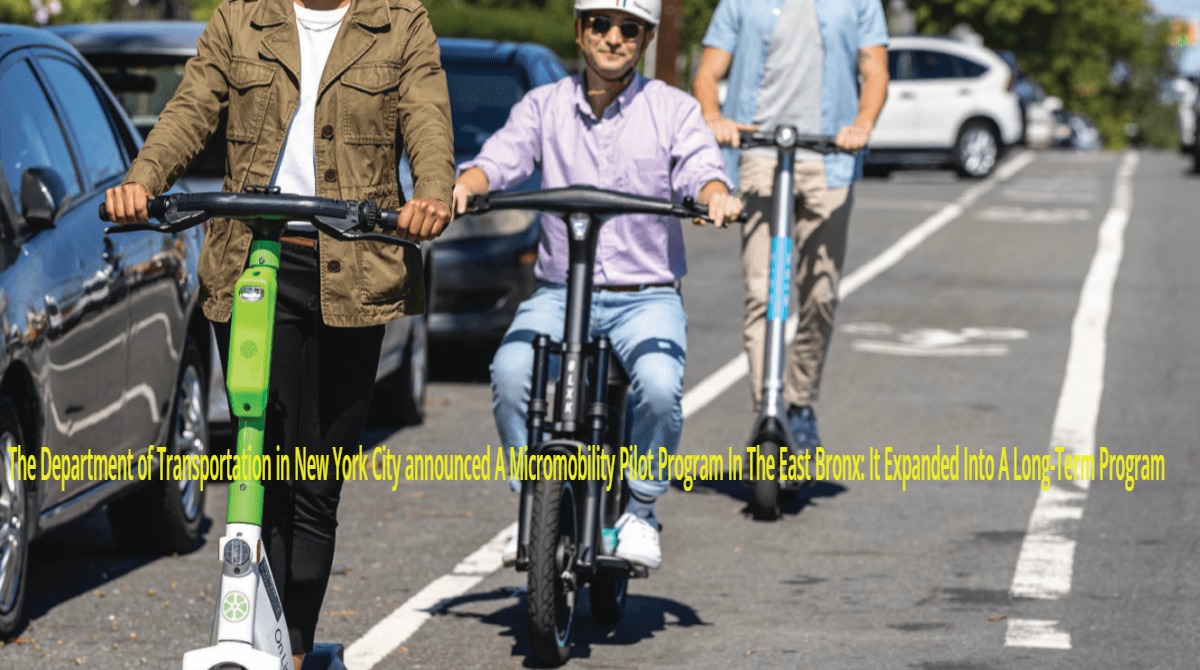The Department of Transportation in New York City announced A Micromobility Pilot Program In The East Bronx: It Expanded Into A Long-Term Program
The New York City Department of Transportation’s commissioner (NYC DOT) has asked for proposals to increase micromobility. With the potential to make a pilot that started in the East Bronx last year permanent. A report detailing the accomplishments of that pilot. Which has completed more than 1.4 million rides without a single fatality and only a handful of severe injuries since its launch in August 2021. Also made public by the agency.
Commissioner Ydanis Rodriguez states, “Today, we’re announcing that the shared e-scooter pilot program I backed in my council position will work toward becoming a long-term initiative.” This pilot’s ambitious goals for safety, mobility, and equity were met and exceeded on the streets of the East Bronx. We are now preparing to do even more for more communities.

In August 2021, DOT began the incredibly popular East Bronx Shared E-Scooter Pilot in a few East Bronx neighborhoods. With the addition of a second phase ten months later. The program eventually included three companies and covered communities from Wakefield and Pelham Parkway to Soundview. These three businesses—Bird, Lime, and Veo—provided 6,000 shared electric scooters for the pilot. The current pilot program will run at least through the summer of 2023. The RFP expresses the intention to keep providing shared micromobility for other communities and residents of New York City after 2023.
The pilot’s one-year evaluation showed that it gave historically underserved communities practical and accessible mobility options. Reducing their reliance on cars by providing an eco-friendly mobility alternative. Specifically, in areas not serviced by Citi Bike. The Local Law 74 of a 2020-initiated pilot program sought to test the viability of e-scooters.

Four objectives guided the pilot’s launch by the NYC DOT:
- Establish stringent safety standards
- Evaluate the usefulness of shared e-scooters for transportation.
- Reduce sidewalk debris to protect the public right of way.
- Examine the participating companies’ viability and capacity to adhere to the pilot requirements.
After observing early success in the program’s first ten months. NYC DOT expanded the pilot in the East Bronx further south in June 2022. Doubling the number of e-scooters and incorporating nine new neighborhoods. Nearly 600,000 New Yorkers lived in the combined pilot area, more than 80% of whom were non-White. There were 25 NYCHA developments.
NYC DOT mandated stringent safety requirements, such as for new riders, there is a “beginner mode” and age verification. Who had to complete a safety quiz, travel at a slower pace, and were not permitted to take their first rides overnight. For NYC DOT to monitor whether the e-scooter operators were abiding by the terms of the pilot program and to spot any operational issues, the operators also required to share system data as part of the pilot’s requirements.
The NYC DOT required all e-scooter rides to end at designated corrals for e-scooters, totaling about 130 in the pilot area. In the pilot service area, the NYC DOT also expanded the city’s network of bike lanes, with many projects already finished (such as the brand-new protected lanes along Bronxdale Avenue) and others scheduled for completion in 2023.
The NYC DOT evaluated user and non-user survey data gathered between September 2021 and May 2022. Also from August 17, 2021, to August 31, 2022, trip and other system data as part of the pilot program. The results of the NYC DOT evaluation showed that the pilot generally succeeded in achieving. Its primary objectives of safety, mobility, operations, parking, equity, and community involvement.

